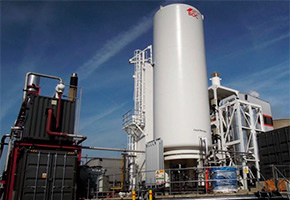

Process should optimize the use of renewable sources such as solar and wind power, reducing the effects of intermittent supply to the power grid (photo: University of Birmingham)
Process should optimize the use of renewable sources such as solar and wind power, reducing the effects of intermittent supply to the power grid.
Process should optimize the use of renewable sources such as solar and wind power, reducing the effects of intermittent supply to the power grid.

Process should optimize the use of renewable sources such as solar and wind power, reducing the effects of intermittent supply to the power grid (photo: University of Birmingham)
By José Tadeu Arantes
Agência FAPESP – The United Kingdom will use liquid air to store energy from renewable sources (solar and wind). The method, already pilot ted, is expected to go into commercial production in 2018.
According to those in charge of the project, the approach seeks to help overcome the highs and lows in supply caused by the intermittent availability of renewable energy sources. Stored in liquid air, the power would be available for consumption even on cloudy days or on days with no wind.
The project was explained by Professor Richard Williams, dean and director of the School of Engineering and Physical Sciences of the University of Birmingham in the United Kingdom, in a lecture at FAPESP during the event “UK-Brazil interaction meeting on cooperation in future energy system innovation,” which was held to promote scientific cooperation among Brazilian and British researchers in energy-system innovation.
“One 350-kilowatt (kW) pilot plant currently connected to the electrical grid in the United Kingdom has been in operation for three years. This unit is now being transferred to the University of Birmingham as a test platform. And the government has made £8 million in funding available for a 5-megawatt (MW) demonstration unit, which is expected to be in operation by mid-2015. All of this is being done so that we will have a commercial option for liquid air storage by 2018,” Williams told Agência FAPESP.
The physical principle behind the process is relatively simple. Seven hundred and ten liters of air cooled to a temperature of minus 196 (−196) degrees Celsius produces one liter of liquid air. This liquid air may be stored for later expansion, when it comes into contact with a heat source. The air expansion is then used to activate a turbine, converting the mechanical energy to electrical power.
Liquefied air is one way to store energy from intermittent renewable energy sources, such as solar and wind power, ensuring that the grid undergoes no decrease in supply at times of little sunshine or wind.
According to Williams, by thus making optimal use of renewable energy sources, cryogenic storage (which utilizes very low temperatures) is becoming an increasingly important part of the British policy of power-grid decarbonization.
The Climate Change Act, passed by the British Parliament in 2008, calls for an 80% reduction in carbon gas emissions (CO2) by 2050. The Renewable Obligations of the act specify that electrical power suppliers licensed in the United Kingdom have to supply an increasing percentage of electricity generated from renewable sources, establishing the band at 15% for 2020.
“Because liquid air for storing energy becomes more efficient above 10 MW, it is not appropriate for use in individual buildings but is quite suitable on the scale that goes from the neighborhood or industrial park to the city. In the area of transportation, one possibility is its use in hybrid technology solutions to increase the efficiency of diesel engines in trucks or short-distance ferries, for example,” said Williams.
Increased efficiency
When taking into account the two cycles, cooling and reheating air, the expected efficiency of the process during the demonstration phase is approximately 60%, said the dean of the University of Birmingham.
“But efficiency could be increased to 80% or more by using residual heat during the expansion cycle. Another way to further increase efficiency is to combine the liquid air production units with liquefied natural gas terminals in order to make use of the residual cooling produced in these terminals during the phase of reconverting gas to its original gaseous state,” he explained.
According to Williams, the direct environmental impacts of the process are expected to be very low. “For energy storage, it is only air that the device captures and empties. And when cryogenic storage is used in engines, it is again air that is traded with the environment,” he said.
“Since the operating temperature of these engines is less than that of conventional internal combustion engines, the components may be manufactured out of plastics instead of metals, thus reducing the energy involved,” Williams argued.
Elected “University of the Year” by The Times and The Sunday Times newspapers, the University of Birmingham has among its current priorities the creation of sustainable, innovative solutions.
The university has therefore aligned itself with four other British universities (Hull, Leeds, Sheffield and York) to form the Centre for Low Carbon Futures, which brings engineers, natural scientists and social scientists focused on alternative energy and climate change together with governments, companies and civil society entities.
The Birmingham Centre for Cryogenic Energy Storage, established in association with the University of Hull, is part of this initiative.
The University of Birmingham has signed a cooperative agreement with FAPESP to fund collaborative research projects between the state of São Paulo and the United Kingdom. Two calls for proposals have already been issued under the agreement. Seven proposals were selected in the first of these calls.
Republish
The Agency FAPESP licenses news via Creative Commons (CC-BY-NC-ND) so that they can be republished free of charge and in a simple way by other digital or printed vehicles. Agência FAPESP must be credited as the source of the content being republished and the name of the reporter (if any) must be attributed. Using the HMTL button below allows compliance with these rules, detailed in Digital Republishing Policy FAPESP.





